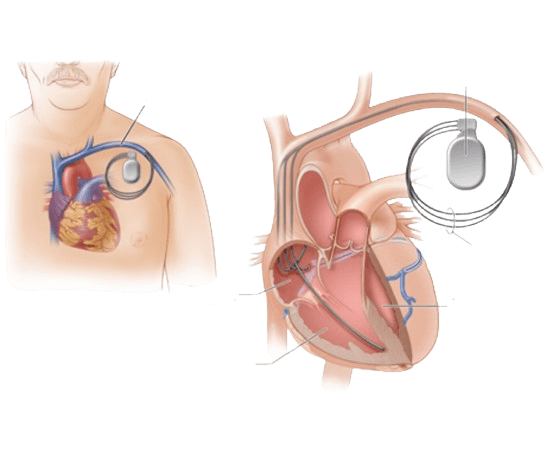

Biventricular Pacing
Biventricular pacing, also known as cardiac resynchronization therapy (CRT), is an advanced treatment for certain types of heart failure. In this therapy, a special type of pacemaker is implanted to coordinate the pumping action of both the right and left ventricles. By improving the synchronization of the heart’s contractions, biventricular pacing enhances blood flow, reduces symptoms, and improves the quality of life for patients who do not respond well to standard treatments.
Why and When is Biventricular Pacing Required?
Heart failure occurs when the heart cannot pump blood efficiently, often due to weakened heart muscles or electrical conduction problems. Some patients develop a condition called ventricular dyssynchrony, in which the right and left ventricles do not beat in harmony. This lack of coordination can worsen heart failure symptoms.
Biventricular pacing is usually recommended when:
- Patients suffer from moderate to severe heart failure (NYHA class III or IV).
- The left ventricular ejection fraction (LVEF) is 35% or less.
- There is evidence of bundle branch block or abnormal electrical conduction.
- Medications alone fail to control symptoms effectively.
Symptoms That Indicate the Need for Biventricular Pacing
Patients who may benefit from this therapy often experience:
- Persistent shortness of breath, even at rest.
- Swelling in the legs, ankles, or abdomen due to fluid retention.
- Chronic fatigue and inability to perform daily activities.
- Rapid or irregular heartbeat.
- Frequent hospital admissions for worsening heart failure.
How is Biventricular Pacing Performed?
The procedure is minimally invasive and performed under local anesthesia with sedation.
- Pacemaker Implantation – A small incision is made below the collarbone to place the biventricular pacemaker device.
- Lead Placement – Thin wires (leads) are guided through veins into the right atrium, right ventricle, and the left ventricle via a coronary vein.
- Device Programming – The pacemaker is programmed to deliver synchronized electrical impulses to both ventricles.
- Recovery – Patients usually stay in the hospital for 1–2 days and can resume light activities within a week.
Types of Biventricular Devices
There are mainly two types:
- CRT-P (Cardiac Resynchronization Therapy – Pacemaker) Provides pacing therapy to resynchronize heartbeats.
- CRT-D (Cardiac Resynchronization Therapy – Defibrillator) Combines pacing with a defibrillator that can deliver life-saving shocks during dangerous arrhythmias.
Benefits of Biventricular Pacing
Biventricular pacing offers several proven advantages, including:
- Improved heart function and pumping efficiency.
- Reduction in symptoms of breathlessness and fatigue.
- Enhanced ability to perform daily activities.
- Lower hospitalization rates for heart failure.
- Increased life expectancy in advanced heart failure patients.
Recovery and Life After Biventricular Pacing
Most patients report significant improvement within weeks after the procedure. Long-term care involves:
- Regular follow-ups with a cardiologist.
- Periodic device checks and reprogramming if needed.
- Taking prescribed medications consistently.
- Maintaining a heart-healthy lifestyle with proper diet and exercise.
Why Choose CureU Healthcare?
At CureU Healthcare Services, we connect international and domestic patients with top cardiac specialists and accredited hospitals in India. Our expert team ensures:
- Personalized treatment plans.
- Transparent cost estimates.
- End-to-end assistance from consultation to recovery.
- Compassionate care tailored to each patient’s needs.
Conclusion
Biventricular pacing (CRT) is a groundbreaking therapy that restores the heart’s natural rhythm, reduces symptoms of heart failure, and extends survival in critically ill patients. With India offering world-class expertise at affordable costs, patients from across the globe can benefit from this life-saving treatment through CureU Healthcare Services.




